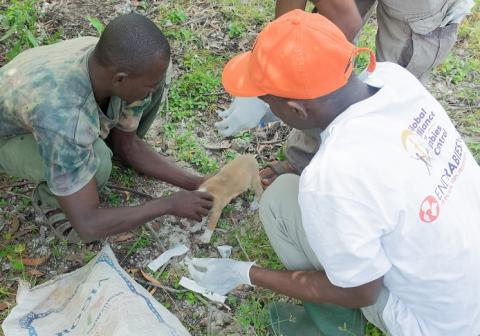The use of ivermectin in a rabies vaccination campaign
The Zanzibar mass rabies vaccination campaign began in August 2017. Global Alliance for Rabies Control (GARC) representatives offered their guidance in the first two weeks of the campaign to assess, assist and guide the teams in a number of areas, including humane animal handling, vaccination techniques and reaching adequate vaccination coverage.
The total estimated canine population of Zanzibar is 9,000 dogs, and GARC and World Animal Protection donated 10,000 doses of Rabisin vaccine. The campaign was primarily conducted by the Zanzibar Agriculture Department, and they determined that it was important to give a shot of ivermectin to every dog along with the rabies vaccine.
Ivermectin is a widely utilized and effective parasiticide with a broad spectrum of activity utilized in a variety of species. However, neurotoxicity is possible in dogs (particularly in those with a defect in the MDR1 gene), with shock, vomiting, hypothermia and depression commonly encountered. In non-sensitive breeds, and at appropriate dosage of less than 1mg/kg (1000 micrograms/kg), toxicity is rarely seen.
In Zanzibar, the GARC team observed more minor negative reactions in approximately 60% of the treated dogs. Reactions ranged from a subtle itching at the injection site to a more frantic rolling on the ground and running around to an even more problematic reaction of screaming, scratching and running. These reactions seemed very unpleasant for the dog and although short-lived, they had a detrimental influence on the campaign. Dogs brought to be vaccinated are typically under a heightened level of stress and anxiety, and witnessing the distress of other dogs may cause some to react negatively. Owners could lose control of these dogs resulting in a lack of vaccination for these animals, thus reducing the overall percentage of the dogs vaccinated.
The team felt it was important to look for a solution that could minimize reaction and stress to the dogs. The GARC team set about observing the location of the injection site, as well as the manner in which ivermectin was drawn into the syringe. In this campaign, the size of the needle (23 gauge) or syringe (1 ml) could not be changed.
Dogs were injected subcutaneously (SQ), with the commonly utilized site being over the ribs on the opposite side of the dog that the rabies vaccine had been given. The team changed the injection site to the scapular region while still utilizing the SQ route. In general dogs should not be vaccinated or given injections around the ribs as this site is typically more sensitive and painful. The change in site appeared to decrease the number of reactions observed but did not eliminate them.
The team also observed that the needle was fully pushed into the ivermectin bottle, and coated with the solution before being drawn into the syringe. The team then advised that only the tip of the needle be inserted to minimize coating, as it was not known whether reactions were localized to the dermis or the sub-dermis. This remedy, combined with the change in location site to the scapular region, further reduced reactions.
Our theory, that the reactions the dogs were experiencing were localized to the dermis, has been observed by the veterinary profession, but it is not well documented. Thus, the solution noted above as a standard of practice made the team feel comfortable. Another commonly utilized veterinary practice is to insert and leave a needle in the ivermectin bottle to be utilized and to draw up solution into each syringe and inject the dogs with fresh, uncoated needles.
These simple modifications reduced canine reactions, leading to less discomfort and pain for the dog, and thus improved the vaccination coverage. It is important for any vaccination team to strive for the best experience for both the dog and the owner as this leads to positive word of mouth and increased vaccination rates at future mass vaccination campaigns. No vaccination campaign occurs one time, and increasing the human animal bond and building the trust of the community with the vaccination team is vital.
Contributed by Daniel Stewart, an animal behaviourist working with GARC who was part of the advisory team in Zanzibar
